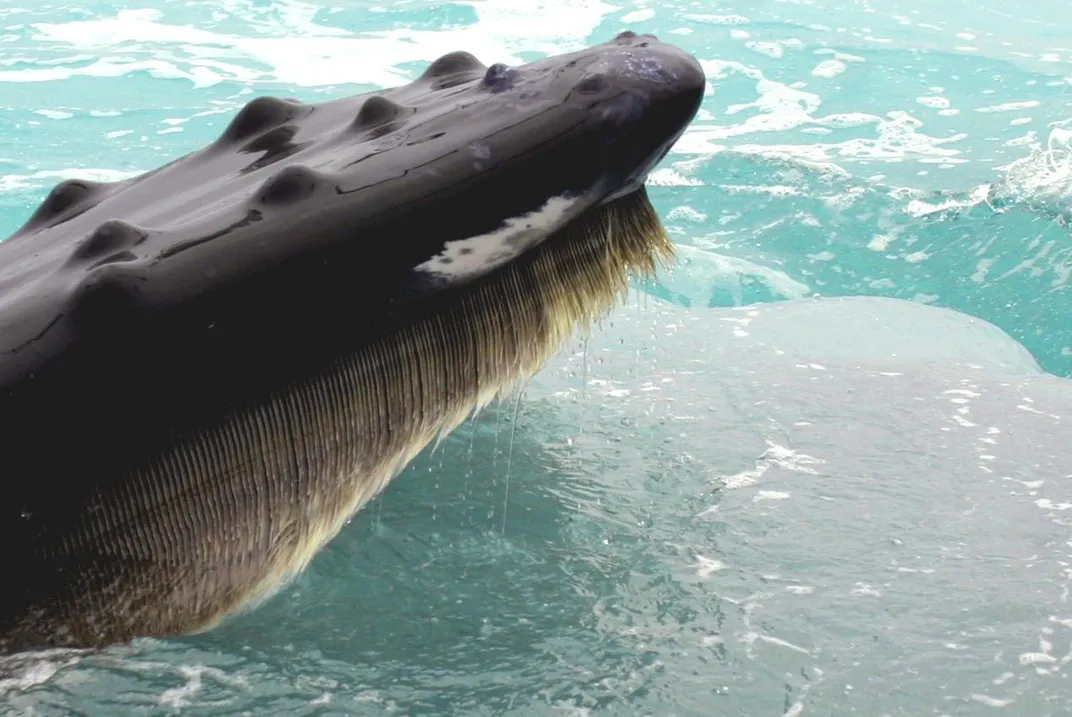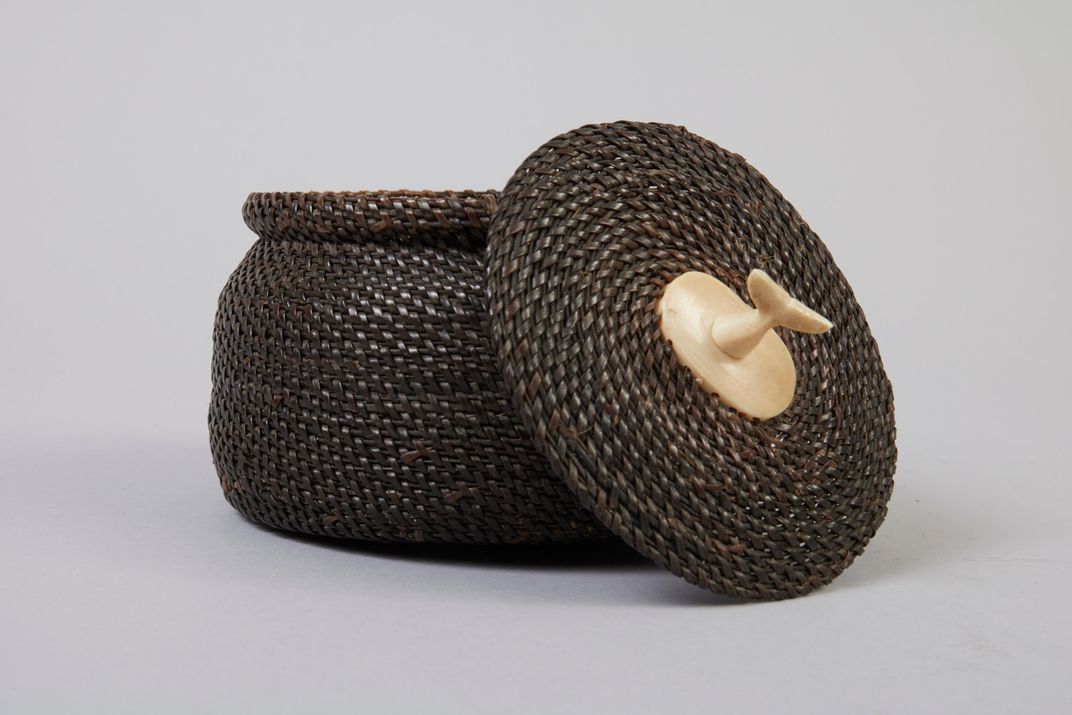These Ancient Whale Baleen Artifacts Can Now Tell New Stories
How an innovative protein analysis technique helped solve a decades-old mystery
/https://tf-cmsv2-smithsonianmag-media.s3.amazonaws.com/filer/9d/bb/9dbba08d-e222-4b87-8f3c-8e11695f33f6/nhb2017-01417.jpg)
Rocky, flat, and all but free of vegetation, Avayalik, an island near the northern tip of Labrador, Canada, is no one’s ideal vacation destination. Nevertheless, its spare terrain is peppered with archaeological sites that suggest human activity and habitation dating back more than 1,500 years.
Almost four decades ago, an expedition co-managed by William Fitzhugh, director of the Smithsonian’s Arctic Studies Center, returned from Avayalik with an array of artifacts recovered from those prehistoric sites.
Among them were bundles of baleen, a bristly filtration system found in the mouths of Mysticeti whales. When treated properly, baleen is a remarkably flexible material—so much so that some researchers refer to it as “nature’s plastic.” Indigenous peoples have, among other things, woven this pliable material into baskets and stripped it to make fishing lines. During the commercial whaling era, artisans would even incorporate it into corsets and parasols.
Studying those samples from Avayalik, however, Fitzhugh and his colleagues couldn’t be sure what they had. Their confusion was about more than the practical purpose of those baleen bundles: The ancient peoples of Avayalik may have been using their contents as lashings or components of traps, but details about the substance itself were scarce.
Though the cold had preserved the material well, distinctive patterns had degraded and colors had faded, making it all but impossible to determine what species of whale it had come from. At the time, Susan Kaplan—now the director of Bowdoin’s Perry-MacMillan Arctic Museum and Arctic Studies Center, but then a Smithsonian-affiliated PhD student—thought she might have a way to find out.

“There was this fancy thing called an electron scanning microscope,” Kaplan says, referring to a powerful tool newly available at the Smithsonian. Electron scanning microscopy, capable of rendering magnified images of the nanoscale, is used to examine—and sometimes manipulate—specimens at the molecular level. In an effort to find out if it could help here, Kaplan received permission to extract tiny slivers of material from the baleen samples that her fellow researchers had brought back. She carefully placed those miniscule—but not quite microscopic—samples into sealed and clearly-labeled glass vials. As she recalls, “My question to people was, Can you identify [the species of the] baleen on the scanning microscope?”
It turned out that they couldn’t, but Kaplan’s preparation still paid off—it just took much longer than expected.
For years, Kaplan’s sample collection remained in Fitzhugh’s office, tiny mementos of Avayalik’s still-untold stories. That’s where they might have stayed, if Caroline Solazzo, a molecular biologist with the Smithsonian’s Museum Conservation Institute, hadn’t approached Fitzhugh with another possibility, a technique that might succeed where the electron scanning microscope had fallen short.
Solazzo’s suggested method is known as peptide mass fingerprinting. It’s an approach that involves breaking proteins down into shorter amino acid chains. If you know what you’re looking for, you can target a specific protein, keeping an eye out for known molecular biomarkers that allow you to identify its source. Among other things, it’s both cheap and fast, especially compared to more conventional DNA analysis, which would, in any case, have been almost impossible, given the degradation of ancient samples like those recovered from Labrador. “DNA is a much more cumbersome process,” Fitzhugh says. “It’s expensive. It’s subject to contamination, and things like this.”

Baleen was a strong fit for the method, since, as Solazzo explains, it “is mostly made from one type of protein: alpha-keratin. It’s the same family of proteins found in hair, nail, horn, hoof.” In that light, she thought it might be possible to finally identify the samples Kaplan had archived long before.
As it turned out, Solazzo was correct. In a paper recently published by the open access journal PLOS ONE, she and her co-authors write that she successfully applied the fingerprinting technique to 29 fragmentary samples, finding that the vast majority came from bowhead whales. Relatively common in arctic and sub-arctic waters, including those off the Labrador coast, bowheads have strikingly peculiar jawlines that resemble cartoonishly crooked smiles when their mouths are closed. Though they were heavily fished during the golden age of European whaling—and, it would seem, in the far more distant past as well—they are considered a species of low concern today.
Solazzo’s success is a striking accomplishment, in part because it testifies to the benefits of peptide mass fingerprinting more generally.
That angle also impressed William Cioffi, a PhD student working on issues related to whale conservation at Duke University. “It looks like a great technique,” Cioffi said after reviewing the paper. “If you have samples you’re unable to get DNA from, it looks like a great way to get information about species.”
While the results of Solazzo’s analyses are fascinating in their own right, they may open the door for even more important future work. As she acknowledges, “[T]he technique is destructive, even though we need very little” material. Accordingly, analyzing some of the artifacts in the Smithsonian’s collections may be a tricky proposition, even if it would be helpful to know more about the animal remains incorporated into them.

Having shown that it’s possible to identify whale species from baleen, Solazzo says, “Now we have a new tool to study those collections.”
Solazzo’s success is, however, more than a proof of concept: As she and her co-authors note, it might also contribute more directly to ongoing conservation efforts. By helping us understand which kinds of whales were being hunted in a given region at particular points in the past, it could grant us a better understanding of how populations have changed over time.
“We’re still trying to understand how both of those populations—the bowhead population and the right whale population—were decimated, when they were decimated, and what their original population sizes might have been,” says Andrew J. Reid, professor of marine biology at Duke (and Cioffi’s adviser). “Any insight into either early post-contact European whaling or even pre-contact aboriginal whaling is helpful in that regard.”
Perhaps even more importantly, baleen may have other stories to tell. In their paper, Solazzo and her co-authors note that baleen may effectively encode evidence of climate change and other environmental issues. Expanding on that point in conversation, Fitzhugh compared the material’s potential to that of ice cores, which can help us track atmospheric levels dating back hundreds of thousands of years.
“Baleen grows and it incorporates environmental signatures as it grows and freezes those into baleen,” he says. “When you have these big bowhead whales that now we know live to be a couple hundred years old, now we’ve got these great environmental records. It’s like an archive of pollution, of water temperature, salinity, all sorts of things we need to know about the environment in the past.”
Cioffi, likewise, suggested that the paper was exciting in part because it may help us find out even more about these long dead whales and the waters through which they swim. “There is a lot of baleen in small pieces, or incorporated into artifacts that is interesting archaeologically, but there is a lot of this information about environment and biology trapped in there as well,” he says. “It’s a great little window into the past, in a way that we can’t get that kind of biological data now.”
While such discoveries may come in time, Fitzhugh suggests that what we’ve already learned speaks to the real potential of museums.
“When you collect things you really don’t know what their purpose might be later on,” he says. “If you collect stuff just for a particular need you have right now, you often don’t have the materials you need to use when new techniques are developed to study them or figure them out. So, this is a good case of old collections at the Smithsonian becoming valuable because of new scientific techniques that are developed to study and analyze them.”
Kaplan, meanwhile, is pleased with the findings. “It’s so nice to see the baleen work in print,” she says. After all these years, though, she finds herself thinking of Avayalik again. She’s even hoping to make a return trip soon. We still have much to learn from the artifacts we already have, but there are many more yet to be discovered.